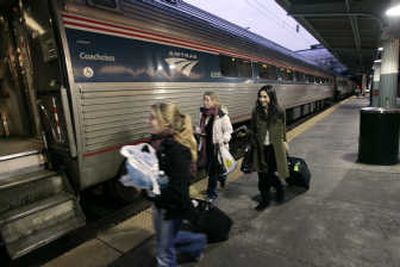All aboard Amtrak

Given the ever-climbing price of gas at the pump, and the shrinking number of airline flights this summer, not to mention soaring airfares due to fuel costs, it’s time to look at Amtrak as an alternative.
While Amtrak is not without negatives – awful on-time records, aging equipment, some inconvenient schedules – trains remain a viable and comfortable means of travel.
For those who have ridden the rails in Europe, but not in the U.S., forget about comparisons. Unlike the Europeans, Americans don’t have any trains that clip along at 186 miles an hour.
The closest equivalent is the Acela, engineered to go 150 mph in the Northeast Corridor of Washington-New York-Boston but mainly travels at 125 mph and below. For other Amtrak trains, the speed limit is a snail-like 79 mph.
Because Amtrak trains must yield to freight traffic, and infrastructure breakdowns plague both, it’s no wonder that Amtrak has on-time problems. Last year long-haul trains had on-time records that vie with the airlines: the California Zephyr, 23.6 percent; the Empire Builder, 64.5 percent; and the Southwest Chief, 76.3 percent.
Nevertheless, if you can take a deep breath and relax, a train trip might be a great option.
To be sure, ridership is up.
“Our advance booking volumes are high and (ridership) is up 10.8 percent year to date, with a lot of momentum going into the summer months,” says Marc Magliari, an Amtrak spokesman in Chicago.
Last year Amtrak carried 25.8 million passengers, the most since it started operations in 1971.
If you choose to tough it out in coach – which means sitting and sleeping in your seat for the entire trip – fares are reasonable, but can vary a lot depending on whether you qualify for discounts for seniors, children, AAA members and others.
Sleeping accommodations aren’t discounted and can push your costs into the first-class airfare range, but all meals are included.
Total price for a trip with sleeping accommodations is a combination of coach-class fare (usually the lowest available) for each person plus the accommodation charge. For example, coach seats on the Empire Builder from Seattle to Chicago run from $143 to $318, and a roomette costs from $206 to $617.
The train ride allows you to be a slug, with ample time to read, snooze, daydream and reflect on small-town and backyard America as you zip through dawn, day and dusk.
During the summer, Superliners (like the Empire Builder) generally consist of four sleepers, two coaches, a diner and a sightseer lounge/cafe car.
Coaches have a total of 74 reclining seats. Sleepers are configured with 10 roomettes and five bedrooms on the upper level plus four more roomettes, a family bedroom and a handicapped bedroom on the lower level. Each sleeper has four toilets and one shower.
Some tips for your Amtrak trip:
•Bring a photo ID. Amtrak instituted new security procedures earlier this year that include Mobile Security Teams, random baggage inspections and identification checks.
•Other things you might want to bring: a good map that covers your route, a cell phone, a laptop, an iPod, reading material.
•You can check up to two pieces of luggage for free, but there’s a 50-pound weight limit for each one. If you’re using sleeping accommodations, pack an overnight bag to allow yourself more room in your roomette. And if you’re traveling overnight, keep your medications with you.
•To book a trip, go to www.amtrak.com, phone (800) 872-7245 or call your favorite travel agent.